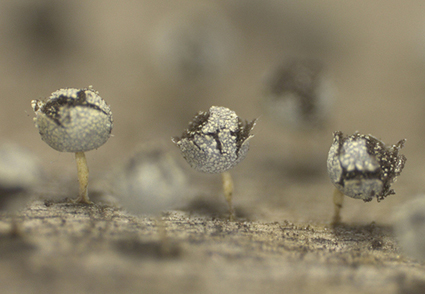Abstract
A new species of Physarum, identified herein as P. karamanicum, developed on debris branches of Cedrus libani collected from the Sarıveliler district of Karaman province in Turkey and applied a moist chamber technique. P. karamanicum is morphologically similar to P. globuliferum, P. auripigmentum, and P. tenerum but is distinguished by sporotheca, stalk, capillitium, and spore features. The new species is characterized by a greenish-gray, globose sporotheca, light brown at the bottom, the remainder yellowish-cream colored stalk, triangular, convex quadrilateral nodes and pale-yellow capillitium, prominent spiny and groups of blunt warts spores, greenish gray peridium. Description of the new species, photographs (light microscope, stereo microscope, and scanning electron microscope), and a key to the closest morphologically related species of the genus are provided.
References
- Baba, H., Gündoğdu, F. & Sevindik, M. (2021) Myxomycetes biodiversity in Gaziantep province (Turkey) with four new records. Phytotaxa 478 (1): 105–118. https://doi.org/10.11646/phytotaxa.478.1.7
- Baba, H. & Sevindik, M. (2019) Mycetozoa of Turkey (checklist). Mycopath 17: 1–14.
- Baba, H. & Sevindik, M. (2022) New records of Myxogastria (Mycetozoa) from the Eastern Mediterranean region of Turkey. Biology Bulletin 49: 85–94. https://doi.org/10.1134/S1062359022020030
- Eroğlu, G. (2021) Cribraria lepida, Physarum dictyosporum, P. diderma, & P. spectabile newly recorded from Turkey. Mycotaxon 136: 853–863. https://doi.org/10.5248/136.853
- Lado, C. (2005–2023) An online nomenclatural information system of Eumycetozoa. Real Jardiìn Botaìnico, CSIC, Madrid, Spain. Available from: http://www.nomen.eumycetozoa.com (accessed 3 March 2023)
- Martin, G.W. & Alexopoulos, C.J. (1969) The Myxomycetes. Iowa Univ Press.
- Nannenga-Bremekamp, N.E. (1991) A Guide to Temperate Myxomycetes. Biopress Limited. England.
- Sesli, E., Asan, A., Selçuk, F. (edlr.) Abacı Günyar, Ö., Akata, I., Akgül, H., Aktaş, S., Alkan, S., Allı, H., Aydoğdu, H., Berikten, D., Demirel, K., Demirel, R., Doğan, H.H., Erdoğdu, M., Ergül, C.C., Eroğlu, G., Giray, G., Halikî Uztan, A., Kabaktepe, Ş., Kadaifçiler, D., Kalyoncu F., Karaltı, İ., Kaşık, G., Kaya, A., Keleş, A., Kırbağ, S., Kıvanç, M., Ocak, İ., Ökten, S., Özkale, E., Öztürk, C., Sevindik, M., Şen, B., Şen, İ., Türkekul, İ., Ulukapı, M., Uzun, Ya., Uzun, Yu. & Yoltaş, A. (2020) Türkiye Mantarları Listesi (The Checklist of Fungi of Turkey). Ali Nihat Gökyiğit Vakfı Yayını. İstanbul.
- Stephenson, S.L. (2021) Secretive Slime Moulds: Myxomycetes of Australia. ABRS, Canberra; CSIRO Publishing, Melbourne, 382 pp. https://doi.org/10.1071/9781486314140
- Stephenson, S.L., Novozhilov, Yu.K. & Prikhodko, I.S. (2020) A new species of Physarum (Myxomycetes) from Christmas Island (Australia). Novosti Sistematiki Nizshikh Rastenii 54: 397–404. https://doi.org/10.31111/nsnr/2020.54.2.397
- Stephenson, S.L. & Rojas, C. (2017) Introduction. xvii–xx. In: Stephenson, S.L. & Rojas, C. (Eds.) Myxomycetes: Biology, Systematics, Biogeography and Ecology. Academic Press, Massachusetts, 474 pp. https://doi.org/10.1016/B978-0-12-805089-7.00017-2
- Ronikier, A. & Lado, C. (2013) Physarum andinum, a new nivicolous species of myxomycete from the Patagonian Andes. Mycologia 105: 162–171. https://doi.org/10.3852/11-397
- Vlasenko, A.V., Vlasenko, V.A., Naumenko Yu.V. & Tomoschevich M.A. (2019) First records of rare epiphytic species Physarum lakhanpalii and Ph. lenticulare for Russia. Turczaninowia 22: 72–79. https://doi.org/10.14258/turczaninowia.22.3.2
- Gilbert, H.C. & Martin, G.W. (1933) Myxomycetes found on the bark of living trees. Univesity of Iowa Studies in Natural History 15: 3–8.


